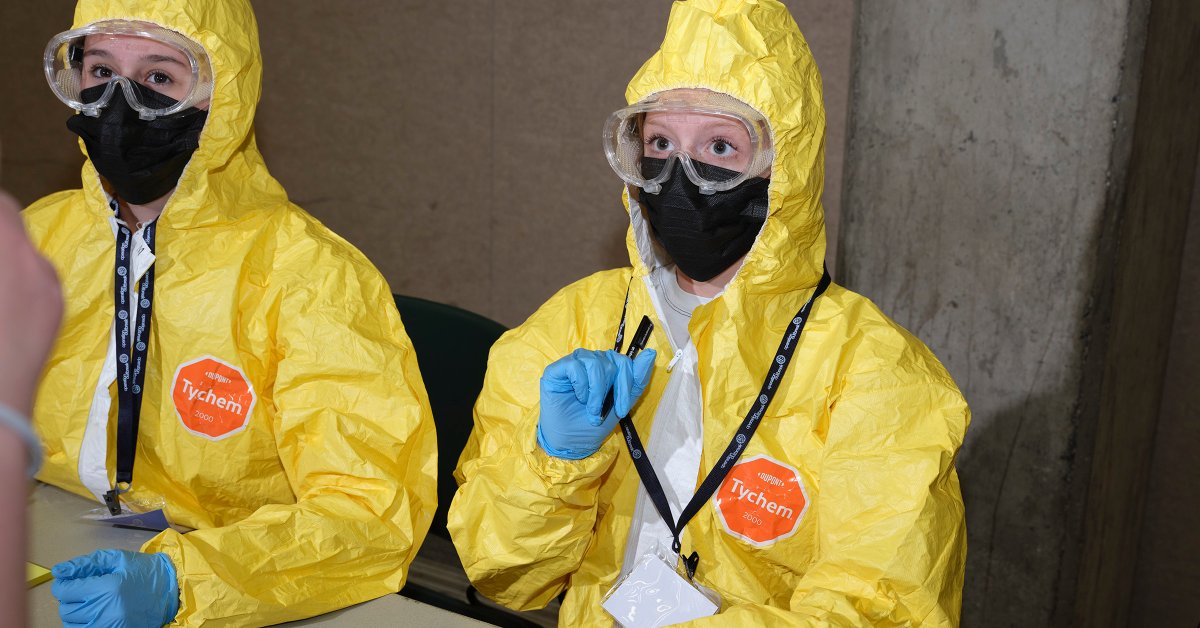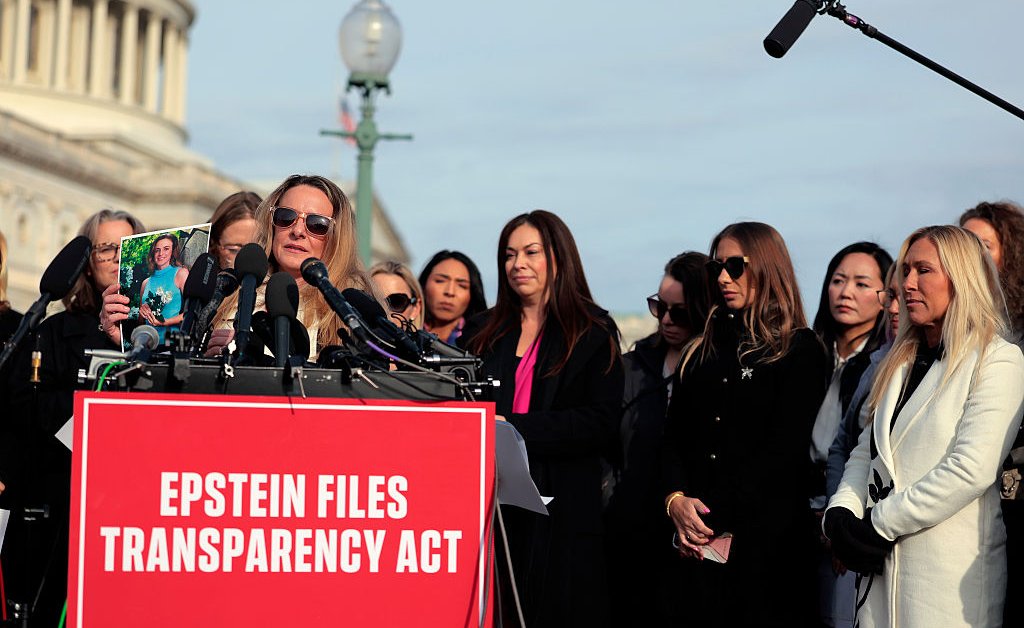We Aren’t Ready for the Next Pandemic. This Game Proves It
On a Friday morning in October, about 100 high school and college students gathered in a Utah ballroom to play a game. Some students were assigned specific roles and given costumes to wear. “Government officials” slung ties over their T-shirts; “store clerks” sported aprons; and a trio of “journalists” wore fedoras and carried fake microphones.
(time-brightcove not-tgx=”true”)
Kambree Carlile, 16, played a “health care worker” and was given full protective gear to wear, including goggles and gloves. As students started getting “sick” with a mysterious and deadly pathogen, panic surged, Carlile says. “It wasn’t a real scenario, but people still got very frantic,” she says.
“Oh no! I’m infected,” students yelled intermittently. Many thronged the health care and public-health stations for advice, treatments, and vaccines, ignoring calls by workers to socially distance. One “infected” student ran around, intentionally coughing on people, causing panic.
One of the “journalists,” 17-year-old Kenadi Burlingame, complained that it had been hard at times to get anyone to listen to her. “The ‘public-health’ people told us that we need to start getting people to quarantine, but I felt like no one really did that. They didn’t see the importance in it,” she says. “That was frustrating.”
Meanwhile, the “biomedical researchers,” who donned white lab coats and were tasked with identifying the pathogen, were baffled by the myriad symptoms that sick people were reporting, including fever, aching muscles, and malaise. “It could be anything,” one of them lamented as she googled people’s symptoms and uncovered a long list of possible diseases.
The students were playing Operation Outbreak, a game that simulates the spread of an infectious disease. During the game, participants use an app on their phones, which alerts them when their avatars are infected and lists their symptoms. The pathogen “spreads” via Bluetooth, from phone to phone.
Creators of the game say it can model how people really behave when disease outbreaks strike. The game has become so good at this that U.S. government agencies including the Federal Bureau of Investigation and the U.S. Centers for Disease Control and Prevention have run its simulations.


In Utah, students who weren’t given specific roles were designated as members of the public and grouped together in “families.” The families moved around the room together, visiting stations where they had to answer questions about infectious diseases and public health. The “bank” paid the families in tokens for correct answers. The tokens could be used by the students to buy food from the “store” to keep their avatars alive, as well as masks, treatments, and vaccines.
“I thought it’d be just a little school activity, but it was realistic,” says Burlingame. “It made me feel sympathetic for people during COVID.”
Burlingame was in fifth grade when COVID first gripped the globe in 2020. “I just remember that one day I was at school and everything was normal, and then the next day the world had shut down,” she says. She remembers it seeming almost apocalyptic at first: the same week that Utah public schools were shuttered, the Salt Lake City area where she lives was shaken by an earthquake and dozens of after-shocks. Burlingame, then only 11, was spooked. Some 5,400 people died from COVID in Utah from 2020 to November 2023.
The teenager is prudent when reflecting on that strange and tumultuous time. “There could be another outbreak,” she says, “and what would we do about it?”
The creators of Operation Outbreak say the game is designed precisely to address this question. It seeks to teach students about the science and risks of infectious diseases, and how interventions such as vaccines and quarantining can curb their spread, says Todd Brown, a former middle-school teacher and one of the game’s co-creators. It also aims to highlight the vital role that every member of society—whether scientist, doctor, government official, or everyday person—plays when outbreaks strike.
“This is a test run,” Brown says. “This is a chance for students to learn how they can potentially save lives, how they could help stop the spread of something in…their school or community.”
Upping the urgency for such preparedness is the prediction by many public-health experts that another pandemic is not just inevitable but close at hand. “We need to be prepared for another pandemic in the next 10 years,” says Pardis Sabeti, an infectious-disease professor at Harvard University and researcher at the Broad Institute who helped create Operation Outbreak.
Read More: Sierra Leone Is Battling an Mpox Outbreak. What Happens Next Affects Us All
COVID was still a distant, unknown threat when the game launched in 2017. Versions of it have since been played by thousands of students in two dozen U.S. states and 10 countries. Its creators say interest in the game increased sharply post-COVID.
“We’ve found that the students tell us the zeitgeist. They tell us the pulse of society, everything that might be coming,” Sabeti says. “We could have predicted a lot of what happened during COVID based on simulations that we did pre-pandemic.”
Students in pre-COVID simulations spontaneously came up with “immunity passports”—ways that participants could prove their vaccination status to get into certain spaces. In some of those same simulations, students figured out how to fake their vaccination status—similar to the fraudulent vaccination cards used by some people during COVID, Sabeti says.
Participants also hoarded supplies, broke quarantine, and even intentionally tried to become superspreaders, a phenomenon later also seen during the pandemic. “We saw chaos, protests, people acting out,” Sabeti says. “Outbreaks expose and exploit all the cracks in our society. Any kind of injustice or issues you have are going to go on steroids—and that’s what we saw in these simulations.”

In some cases, students who had roles of authority, such as members of government, public-health workers, or journalists, disseminated information about the outbreak that later proved to be wrong, often because they spoke too soon in response to public pressure or because new information later became available. “That showed students how science can change as you get new information,” says Brown, the former teacher who now serves as Operation Outbreak’s director of innovation and training. But the fluctuations in messaging often triggered doubt and malcontent among other members of the community.
Game organizers say that mistrust of officials, scientists, and journalists has only deepened and become more common in simulations post-COVID. “The speed of putting up a wall is much faster,” Brown says.
Participants are also more prone to divisiveness and unruly behavior. “At some of our schools, we’ve seen complete societal breakdown, anarchy, and militia,” Sabeti says. (And that was despite students’ taking the game seriously.) “These are things we hadn’t seen before COVID,” Sabeti says.
Read More: What to Know About Chikungunya Amid Southern China Outbreak of Mosquito-Borne Virus
She recalls, for example, a March 2024 simulation at a Utah high school that ended in total chaos. After the “government” struggled to fund health agencies and “researchers” were slow to identify the pathogen and develop a vaccine, disorder and misinformation swelled. A “journalist” spread fake news about masking, people began stealing from the “store” and selling counterfeit goods, others started gambling to increase their own wealth, and a “government official” went rogue—robbing the “bank” and throwing tokens at a crowd. “I represent government intervention,” he declared, according to an internal report of the simulation compiled by game organizers and shared with TIME. “Money to the people!”
Amid the bedlam, participants called for a police force to be established and a “jail” was created. The “government official” who stole from the bank was impeached, and people clamored for his arrest. About an hour into the simulation, the new police force issued arrest warrants for multiple people, including someone who “sold ‘fake vaccines’ to make a profit,” said the report. At 80 minutes, as the simulation came to an end, the report said several students were “running and fighting each other, some arresting others.”
“It scared me,” says Sabeti of the simulation’s outcome. “It suggests that society has formed antibodies to the idea of an outbreak. People are easily triggered, so the next time someone comes on the television and says we are having a lockdown, we could see militia and anarchy.”
Since the COVID pandemic, Americans have lost faith in officials and previously respected institutions. Almost 1 in 4 U.S. adults said in 2024 that they had little or no confidence that scientists would act in the best interests of the public, according to a Pew Research Center survey. In 2019, that figure was 1 in 8.
Only 22% of Americans said they trusted the federal government to do the right thing always or most of the time, according to a different Pew survey from 2024. And more Americans—36%—have no trust at all in the media compared to Americans who have a lot or some trust, according to a 2024 Gallup poll.
“We need to do a lot to repair, because when the next pandemic hits we will be in trouble,” Sabeti says.
Pandemics are expected to occur more often and become more deadly because of climate change, globalization, and more frequent encounters between people and the billions of livestock we raise to eat, as well as wild animals whose habitats we have diminished, public-health experts say.
“It’s going to be less of a freak biological occurrence and more like hurricanes, which are increasing and becoming more devastating,” says Jennifer Nuzzo, director of Brown University’s pandemic center.
There is about a 28% chance that a pandemic as deadly as COVID will happen in the next decade, according to a 2023 report by the disease-forecasting company Airfinity.
Read More: Here’s Why Fewer People Are Vaccinating Their Pets
It is hard to predict which pathogen could launch the next global health crisis, but infectious-disease experts say they are closely watching various outbreaks worldwide for signs of pandemic potential. A rapidly mutating strain of mpox continues to spread across Africa and beyond. Avian-flu strains are circulating in livestock and poultry with some spillover in people. “There are also wildcard viruses out there,” says Sabeti, such as Nipah virus and Crimean-Congo Hemorrhagic Fever (CCHF), which have very high mortality rates and could wreak havoc if they mutate in such a way that makes them more transmissible among people.
A manufactured pathogen is also a danger, Sabeti says. Thanks to advances in biotechnology and AI, a single rogue actor can now feasibly create a biothreat, and because of that, “anything is possible,” she says. “Whether the COVID virus was man-made in Wuhan is beside the point. What is the point is that during COVID, the threat of man-made biothreats went from impossible to improbable to probable.”
Operation Outbreak was first conceived in 2015: Ebola was ravaging West Africa, and Brown was a civics teacher in a Florida middle school. One day, a student in his class asked what would happen if Ebola came to the U.S.
“I responded honestly. I said, ‘I have no idea,’” Brown recalls. “So I posed the question back to the class, and we had this exciting discussion.”
Encouraged by his students’ enthusiasm, Brown brainstormed ways to further engage them on the subject of infectious diseases. It was a topic that was deeply personal to him. Brown’s son is severely immunocompromised, and outbreaks—including the yearly flu season—terrify his family.
Brown had recently read a profile of Sabeti, who had helped develop tools to detect and track deadly diseases including Ebola, in an issue of TIME. Impressed by her work, Brown emailed her, and the pair ended up on the phone. He told her that he had been teaching his students about infectious diseases and that he was planning to put together a simple outbreak simulation so they could get some hands-on experience. Sabeti, who had herself experimented with outbreak simulations in her Harvard classes, was intrigued by Brown’s plans and asked him to stay in touch.
A few months later, Brown assembled some middle schoolers in a field and, using stickers to indicate who had been infected, attempted to simulate what an Ebola outbreak might look like. It wasn’t very sophisticated, but the kids loved it, Brown says. “I reached back out to Pardis with pictures, and she was very excited about it. And it all kind of snowballed from there.”
Read More: Computer Chips in Our Bodies Could Be the Future of Medicine. These Patients Are Already There
Sabeti says she saw an opportunity to create something fun, educational, and sorely needed. She knew that some simple outbreak simulations existed, but nothing that provided students with an immersive, first-hand experience. Her lab already had expertise about how to detect and track diseases, and also how to create educational tools for public-health purposes. She and her collaborators, for example, had helped train researchers across West Africa during the Ebola outbreak.
Her lab set about designing an Operation Outbreak app that could realistically mimic an outbreak. Andres Colubri, a researcher in her lab, had been working on contact-tracing software, which he adapted so it could be used as part of the app to spread a hypothetical pathogen via Bluetooth.
With the help of data-visualization expert Ben Fry, the group also created a dashboard that could display data generated during the simulation, including contact-tracing data and the number of people infected and vaccinated. “The tools we made for the app are the same tools we are creating for outbreaks around the world. Students are working with best-in-class technology,” Sabeti says.
Operation Outbreak is free to use and has been played by schoolchildren from Shanghai and Sierra Leone to Paris and Toronto. Game organizers can choose from a variety of possible pathogens to simulate—from coronaviruses and measles to Marburg virus and tuberculosis.

Kian Sani, Operation Outbreak’s chief of staff, says the hope is to bring the simulation to more professional groups in the near future—including public-health departments, first responders, and companies that might want to bolster their employees’ outbreak preparedness. “A bigger-picture idea that we’re exploring is having a potential city of sorts, maybe using an abandoned parking lot and having multiple buildings. We could invite a bunch of people—public-health workers, doctors, journalists—and have regular people play the general population,” Sani says. “The possibilities are really endless. How can we continually improve how realistic our simulation is?”
Teachers who have organized the game say they like the simulation because, though outbreak science is not typically taught in schools, it complements what students are already learning about biology and civics.
“It helps kids understand the science behind vaccines and being sick and how research works, but also it’s a great pipeline for careers because they get to learn more about different career paths,” says Nichole Kellerman, a biology teacher who has organized Operation Outbreak simulations in two Maryland high schools.

Carlile, the 16-year-old who took part in the Operation Outbreak simulation in Utah, was surprised by how much she enjoyed the game. “I thought it would be weird, just this thing you’d play on your phone, but it was actually really neat to see this virus spreading really quickly and this whole city that was created,” she says.
Along with about 70 of her classmates, Carlile, a junior at Utah’s Lehi High School, played the game at Utah Valley University (UVU) in Orem on Oct. 3. About 30 college students also took part.
Micah Ross, an assistant professor of biology at UVU who organized the simulation, says that despite some turmoil, the students managed the outbreak well. The “biomedical researchers” cracked the mystery of the pathogen’s identity—it was influenza—in just 40 minutes. Once a vaccine was introduced, most students chose to get immunized, and the spread of the disease slowed.
Ross has organized several Operation Outbreak simulations since 2020, both in high schools and at UVU. She sees the game as a chance for younger students to become more scientifically literate. For college students, she thinks Operation Outbreak can be a useful research tool.
Ross co-leads a research group at UVU and runs a class every year in which students are encouraged to use Operation Outbreak as a way to collect and analyze novel data. Her research group is currently working on a study probing whether certain demographic factors influence participants’ decision-making in simulations conducted in Utah.
“We’re curious if there are some decisions that are made more often, say, down south that aren’t made by populations up north. What leads people to getting vaccinated? What factors may cause them not to get tested?” Ross says, noting that the outcome of the study could help inform public-health policy.
Exposure to Operation Outbreak has prompted many of her students to pursue career paths in public health or research, Ross says. “It also helps students become a little more confident in their ability to relate to what’s happening in the world and say, ‘Hey, I’ve been in that position, even if only for an hour.’”
Share this content:




Publicar comentário